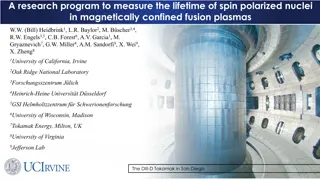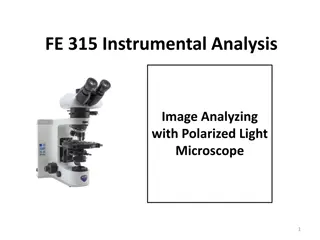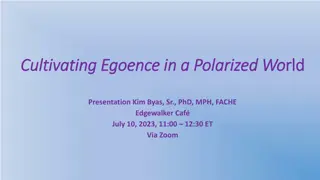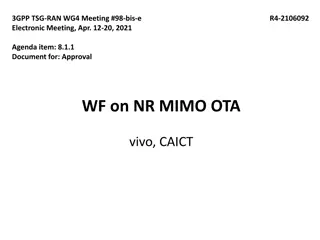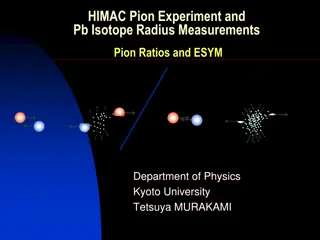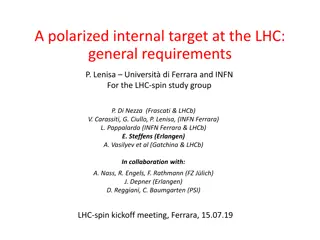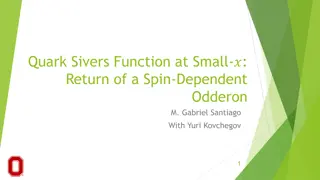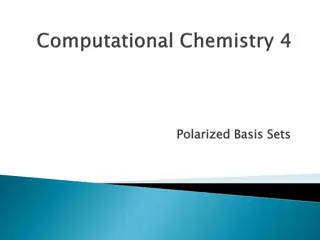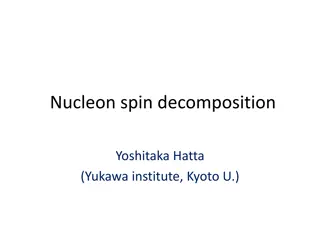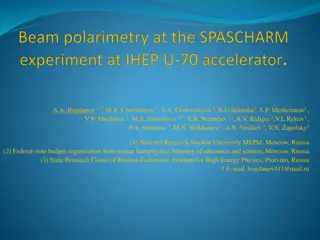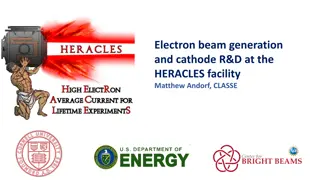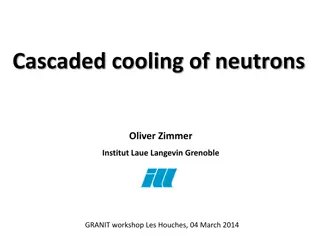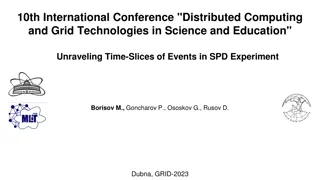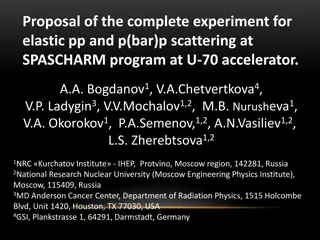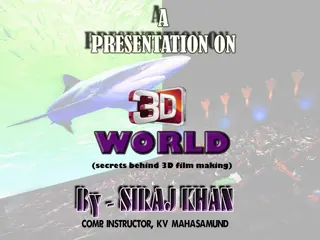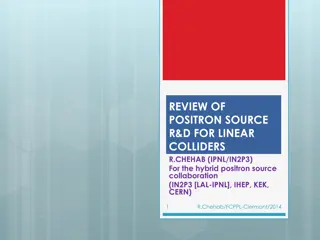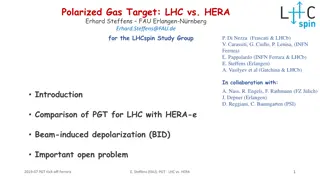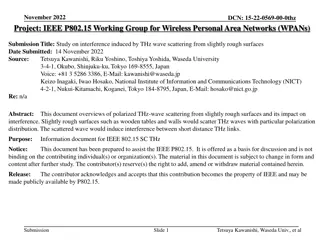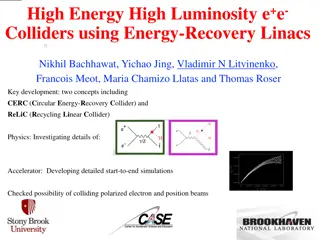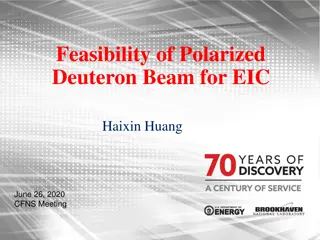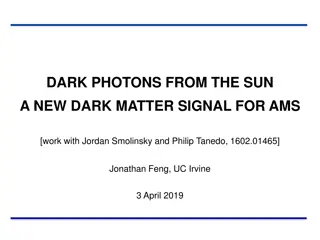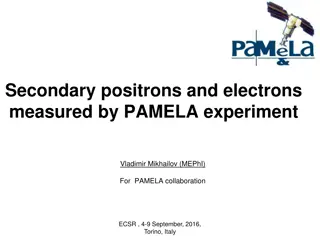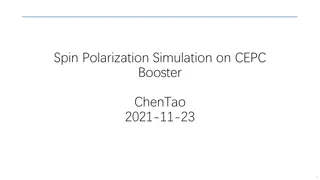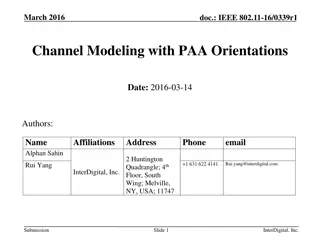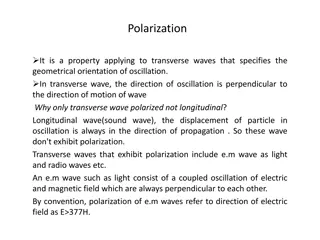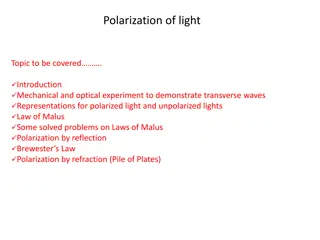High-Energy Recycling in E+ E- Colliders: Energy Recovery Linacs (ERLs) Advancements
High-energy recycling in E+ E- colliders involves the innovative concept of Energy Recovery Linacs (ERLs), pioneered by experts like Vladimir N. Litvinenko. These ERLs effectively recycle energy from collided beams, reducing energy consumption and increasing collider efficiency by maximizing luminos
3 views • 21 slides
Research Program on Spin Polarized Nuclei in Fusion Plasmas
Examination of spin polarized fuel in fusion plasmas to enhance energy production efficiency. Planned experiments aim to measure the lifetime of polarized nuclei for optimized fusion reactions. Key aspects include depolarization mechanisms, neutral beam heating, and fueling techniques with pellets.
3 views • 36 slides
Polarized Light Microscopy in Instrumental Analysis
Microscopes are essential tools for examining small details in samples. Polarized Light Microscopes (PLM) use polarized light to enhance image quality and study birefringent materials. This article covers the basics of microscopes, the principles of PLM, the differences between PLM and LM, and the a
2 views • 16 slides
Cultivating Egoence in a Polarized World Presentation
Living consciously requires egoence, the awareness of oneself in relationship to the whole. Through methods like spiritual practice, meditation, and journaling, one can nurture egoence to support a conscious life amidst constant change in a polarized world. The presentation explores the concept of e
1 views • 10 slides
Simulating Basic PNR and PA Systems: A Practical Approach
Explore how to effectively simulate basic Polarized Neutron Reflectometry (PNR) and Polarization Analysis (PA) systems to enhance proposal submissions and experiment success. Learn about the NIST PNR calculator, useful websites for calculations, and key elements in simulating data for analysis.
1 views • 16 slides
Optical Properties of Optically Active Compounds
Circular dichroism and optical rotatory dispersion are important techniques for studying the optical properties of optically active compounds. Circular dichroism measures the differential absorption of left and right circularly polarized light components, while optical rotatory dispersion studies th
1 views • 17 slides
Approval and Validation Updates for NR MIMO OTA in 3GPP TSG-RAN.WG4 Meeting
The 3GPP TSG-RAN.WG4 Meeting discussed approval for the NR MIMO OTA workplan, addressed FR2 blocking issues, and emphasized the use of polarized antenna models. Updates were made to the power validation procedure and gNB beams usage criteria for FR1 MIMO OTA channel model validation. Collaboration w
1 views • 8 slides
Slow Extraction Operations at Fermilab Main Injector
Overview of slow extraction operations at Fermilab Main Injector, covering beam transport, low to medium energy user test beams, Drell-Yan experimental beam, and spill procedures. Details on beam targets, production, and observation of high-energy positrons. Also, insights on spill regulation techni
1 views • 12 slides
Nuclear Physics Research Highlights: Neutron Stars, Nuclear EOS, and Pb Isotope Studies
Explore cutting-edge research in nuclear physics, including experiments on pion ratios and Pb isotope radius measurements, neutron star observations, neutron density distributions of Pb isotopes, and polarized proton beams at Osaka University. Learn about the analysis of realistic point proton densi
0 views • 26 slides
Study of a Polarized Internal Target at the LHC: General Requirements and Preliminary Results
The LHCb Spectrometer at the Large Hadron Collider is exploring the design of a polarized gas target (PGT) similar to the HERMES target in the VELO alcove. The project aims to improve precision in luminosity measurements for antiproton production in colliding bunches. The new SMOG2 system with addit
0 views • 21 slides
Quark Sivers Function and Spin-Dependent Odderon
Quark Sivers function, a key aspect in quantum chromodynamics, plays a role in capturing orbital angular momentum and spin-orbit coupling. Spin-dependent Odderon, an elusive three-gluon exchange, contributes to cross sections in high-energy collisions. Small-$? TMDs from polarized Wilson lines provi
0 views • 17 slides
Electron Correlation and Basis Sets in Molecular Calculations
Polarized basis sets describe the electron density polarization in atoms and molecules to improve accuracy in computed geometries and frequencies. Diffuse basis sets are recommended for calculating electron and proton affinities. Electron correlations account for electron interactions in molecular c
1 views • 8 slides
John Brown's Role in Escalating Tensions Towards the Civil War
Explore John Brown's pivotal role in the lead-up to the Civil War through his radical abolitionist actions, including the violent events in Bleeding Kansas and his infamous raid on Harper's Ferry. Brown's staunch anti-slavery stance and militant tactics further polarized the nation on the issue of s
1 views • 9 slides
Nucleon Spin Decomposition and Proton Spin Problem
Explore the complex realm of nucleon spin decomposition and the enigmatic proton spin problem, delving into concepts like orbital angular momentum, quarks and gluons' helicity, and longitudinal double spin asymmetry in polarized deep inelastic scattering. Learn about the spin crisis, gluon polarizat
0 views • 26 slides
Measuring Proton and Antiproton Polarization at U70 Accelerator
Absolute polarimeters are described for the beam channel at U70 Accelerator in Russia, focusing on transporting polarized proton and antiproton beams. Various polarimeters are discussed for measuring proton and antiproton polarization, including diffraction and interference-based techniques. The exp
0 views • 37 slides
Examining Two Polarizing Court Cases: Arbery Murder Trial and Rittenhouse Acquittal
Two high-profile court cases - the conviction of three men for the murder of Ahmaud Arbery in Georgia and the acquittal of Kyle Rittenhouse for fatal shootings in Kenosha, Wisconsin - have sparked debates on self-defense, citizen's arrests, and the role of video evidence. The cases exemplify the int
1 views • 5 slides
Electron Beam Generation and Cathode Research at HERACLES Facility
Research at the HERACLES facility focuses on electron beam generation and cathode development for high-current applications. Photocathodes play a crucial role in providing low energy spread beams required for processes like FEL-lasing. GaAs emerges as a promising candidate for spin-polarized electro
2 views • 33 slides
Challenges and Considerations in Electron-Ion Collider Detector Development
Exploring the development of detector systems for Electron-Ion Colliders (EIC) involves addressing various issues such as detector acceptance for low Q2 and high Q2, unique beam characteristics, and the need for specialized components like bend magnets and polarimeters. Key considerations include po
1 views • 16 slides
Achieving High Average Beam Polarization in Particle Colliders
Detailed discussion on achieving high average beam polarization in particle colliders like CEPC, focusing on longitudinal polarized colliding beams, beam polarization requirements, basic formulas, and strategies for maintaining beam polarization during physics runs. Emphasis on scenarios involving s
2 views • 16 slides
Advancements in Neutron Cooling Techniques and Paramagnetic Systems
The presentation discusses cascaded cooling of neutrons and Namiot's proposal for phononless cooling to low temperatures using polarized deuterons. It explores inelastic scattering cross-sections, candidate paramagnetic systems, and excitations in O2. Additionally, it covers rate constants, superflu
0 views • 11 slides
Unraveling Time-Slices of Events in SPD Experiment at the 10th International Conference
In the context of the SPD experiment within the NICA project, the challenge lies in processing vast amounts of data efficiently to extract valuable events. The SPD experiment aims to study the spin structure of nucleons through polarized proton collisions. Approaches like predictive modeling, interp
1 views • 13 slides
Investigation of Spin Observables in Elastic pp and p(bar)p Scattering at SPASCHARM Program
Measurements of spin observables in elastic pp and p(bar)p scattering at 16 GeV will be conducted at the SPASCHARM program using a unique setup with polarized proton and antiproton beams. The experiment aims to extend the energy range for spin studies and compare elastic scattering in pp and p(bar)p
0 views • 24 slides
Enhance Your Vision with Progressive Lens Packages
Explore the range of progressive lens packages offering digital lenses with unparalleled accuracy and clarity. Upgrade your vision with features like wider vision channels and HD-quality optical performance. Additional assets like polarized, non-glare, and Light-Reactive lenses provide optimal visio
2 views • 4 slides
Evolution of 3D Films: From Stereoscopic Headsets to Polarized Glasses
Explore the fascinating history of 3D films, starting from the stereoscopic headsets in 1894 to the polarization technique in the 1940s. Discover how 3D films provide a unique visual experience with depth perception and learn about the evolution of technology to create immersive 3D effects. Delve in
1 views • 28 slides
Review of Positron Source R&D for Linear Colliders by R. Chehab
Intense positron sources, whether polarized or not, are vital for future e+e- linear colliders. This review covers different types of e+ sources, including circularly polarized photons and methods to obtain polarized positrons. Techniques such as helical magnetic undulators and Compton backscatterin
1 views • 26 slides
Comparing Polarized Gas Targets at LHC and HERA for Spin Studies
The comparison between Polarized Gas Targets (PGT) at the Large Hadron Collider (LHC) and HERA for spin studies is discussed. Key considerations such as beam-induced depolarization, beam parameters, and design aspects are highlighted. The importance of using a polarized gas target similar to HERMES
1 views • 15 slides
Study on THz Wave Scattering from Slightly Rough Surfaces: Interference and Implications
Overview of polarized THz wave scattering from slightly rough surfaces such as wooden tables and walls. The document discusses the induced interference between short-distance THz links and presents a model of electromagnetic wave scattering with examples of experimental and numerical results. Potent
0 views • 17 slides
Colliders using Energy-Recovery Linacs
Developments in high-energy e+e- colliders using Energy-Recovery Linacs have led to key concepts like CERC and ReLiC, aiming to enhance luminosity and energy reach. These advancements involve detailed accelerator simulations, flat low emittance beams, energy recycling and reuse, and the possibility
0 views • 11 slides
Feasibility of Polarized Deuteron Beam for EIC
Polarized deuterons have been studied for acceleration in RHIC and EIC. Previous work by S.Y. Lee and E. Courant explored methods such as Siberian snakes and tune jump systems. Scenarios for polarized deuterons have been considered, including the use of detector solenoids as partial snakes. Further
0 views • 23 slides
Racially Polarized Voting Patterns
Racially polarized voting (RPV) occurs when the majority and minority groups vote differently, without requiring discriminatory intent. This phenomenon is studied using ecological inference to analyze how voting patterns vary across regions and districts within Virginia.
0 views • 5 slides
DARK PHOTONS FROM THE SUN A NEW DARK MATTER SIGNAL FOR AMS
The study delves into a new dark matter model where dark matter collects in the Sun and annihilates to dark photons, leading to high-energy positrons - a novel signal for AMS. The dark photon, analogous to the SM photon but with distinct characteristics, plays a crucial role in this model. Considere
0 views • 12 slides
Quark Sivers Function and Spin-Dependent Odderon: Insights from Small-?
Quark Sivers function and spin-dependent Odderon play crucial roles in understanding the three-dimensional structure of hadrons and the asymmetries observed in high-energy scattering processes. Ongoing efforts are focused on determining the small-? asymptotics of these functions and their contributi
0 views • 17 slides
PAMELA Experiment Findings on Positrons and Electrons
The PAMELA experiment, led by Vladimir Mikhailov, measured secondary positrons and electrons, revealing insights into cosmic ray interactions and magnetosphere dynamics. Collaborative efforts and satellite data analysis enhanced our understanding of particle behavior in Earth's magnetic field, showc
0 views • 34 slides
Understanding Spin Polarization and Depolarization in Particle Accelerators
This simulation explores the generation and transmission of polarized beams in the CEPC accelerator, focusing on maintaining beam polarization in the booster and collider regions. It delves into spin motion in a synchrotron, discussing the preservation of polarization in perfect and real ring scenar
0 views • 13 slides
Understanding Nonlinear Media Propagation
Explore the microscopic description of nonlinearity in nonlinear media, including anharmonic oscillators and Lorentz force effects. See how strong incident linearly polarized fields affect electron trajectories and discover the equations governing displacements in x and z directions in a simple case
0 views • 67 slides
IEEE 802.11-16/0339r1 Channel Modeling with PAA Orientations
Explore the impact of polarized antenna orientations on channel capacity in IEEE 802.11-16/0339r1 document. The study proposes including orientation information in the channel model explicitly, shedding light on Jones vector characterization and antenna polarization types.
0 views • 11 slides
Understanding Polarization in Electromagnetic Waves
Learn about polarization in transverse waves like electromagnetic radiation, including linear, circular, and elliptical polarization states. Discover why longitudinal waves like sound waves do not exhibit polarization and explore how unpolarized light can be polarized.
0 views • 5 slides
Understanding Polarization of Light and Laws of Malus: A Comprehensive Guide
Delve into the fascinating world of light polarization, with insights on transverse waves, representations of polarized and unpolarized light, the Law of Malus, practical experiments, Brewster's Law, and more. Discover the essence of electromagnetic waves, the nature of light, and the significance o
0 views • 18 slides
IEEE 802.11-16/1484r1 Multi-Beamforming Procedure for 11ay
Explore the multi-beamforming protocol for 11ay, focusing on polarization antennas and dual-polarization capabilities. Learn about the exchange of multi-beamforming information between initiators and responders using dual-polarized antennas. Dive into the detailed process of multi-beamforming with p
0 views • 10 slides
New Dark Matter Signal from the Sun: Dark Photons Revealed
Explore the groundbreaking research on dark photons and dark matter, proposing a new signal for AMS detection involving dark sunshine and high-energy positrons. The study delves into the characteristics of dark matter populations in the Sun and the potential implications for understanding the dark s
0 views • 12 slides

